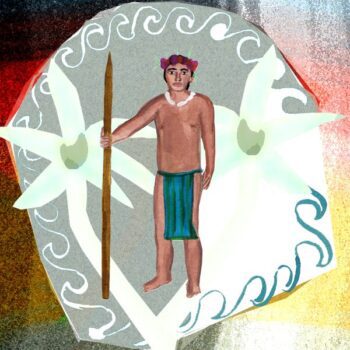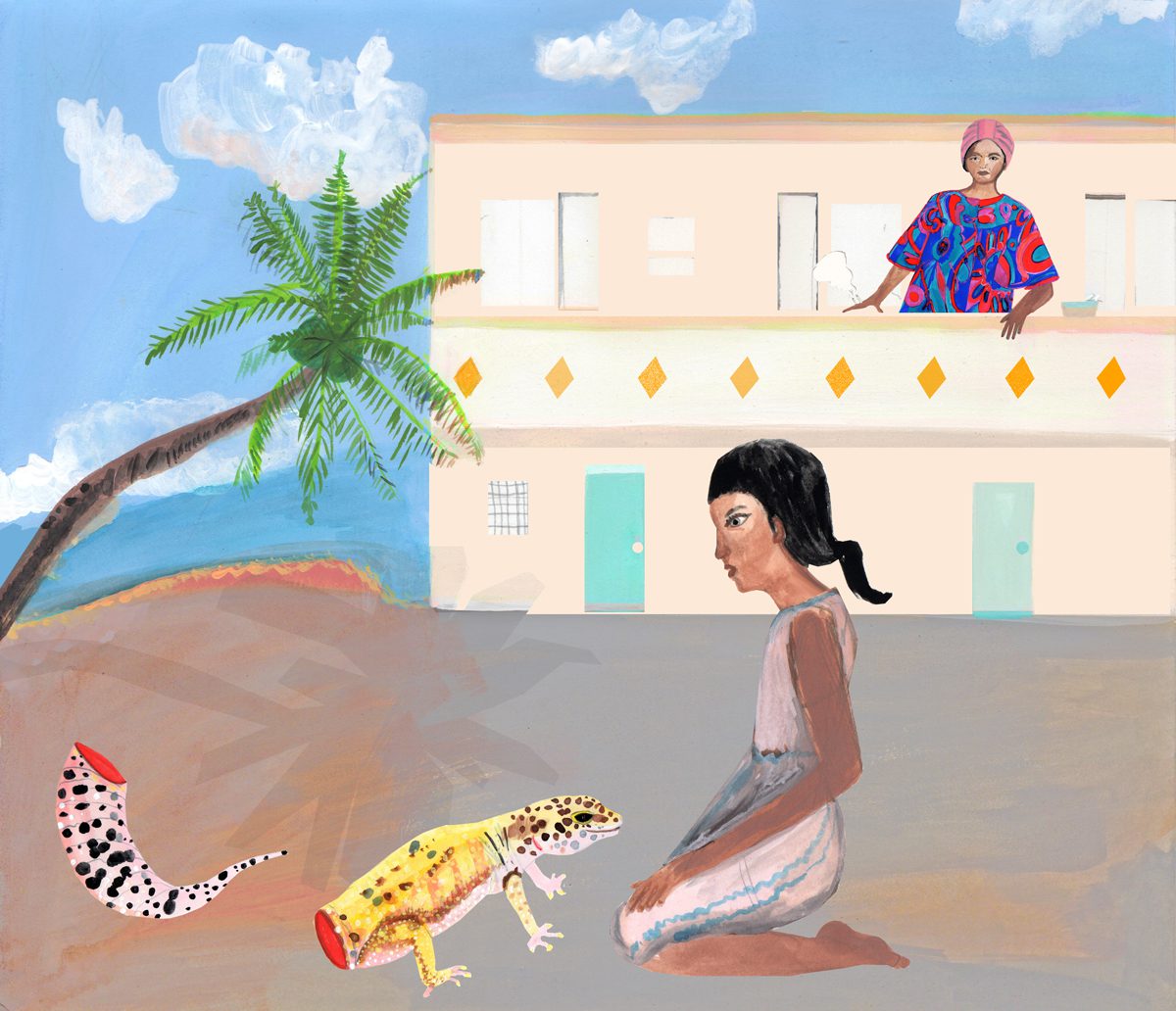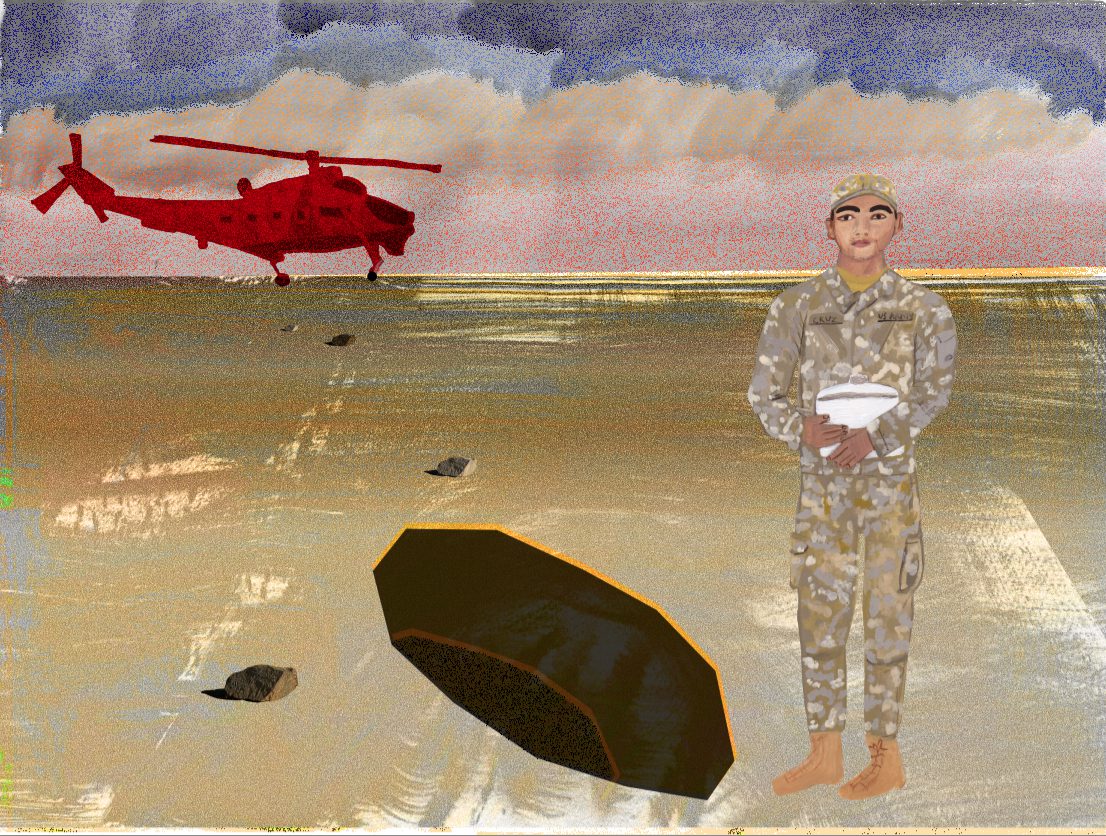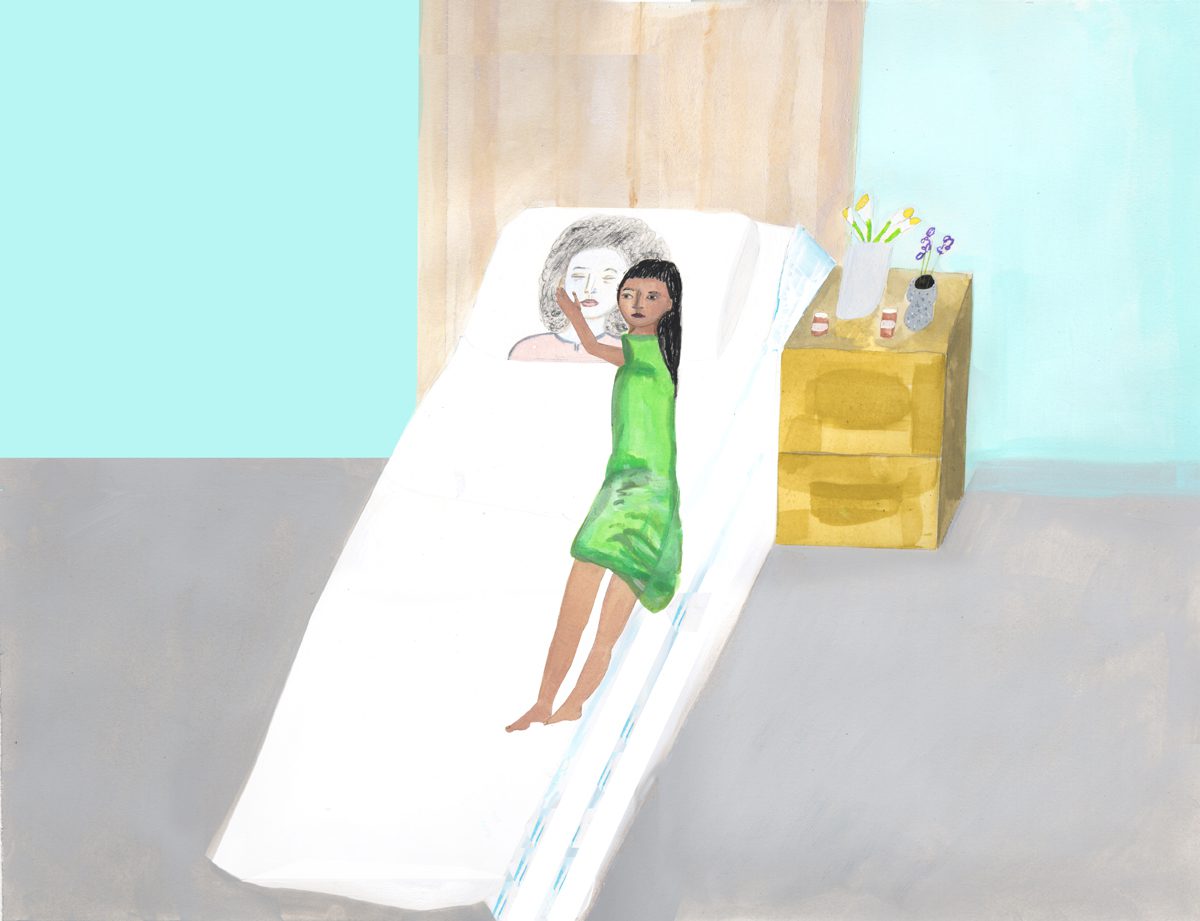
The history of the whole world can be told as the stories of conquerors and the conquered—the former consumed with thoughts of destiny and tyranny, the latter knowing only the persistence of time and the pure grit of bodies. The conquered had to be convinced, against the stars, of the certainty that they could live through all of this.
As with much of the world, my home island of Guam—or Guahan in the indigenous Chamorro language—could peer into its bones and find, in the place of marrow, survival. Now a US territory, Guam first passed between the hands of the Spanish, the Japanese, and then the Americans. During the Japanese occupation in the early 1940s, my grandmother’s older brother Gregorio, who worked as a translator for the Japanese, took a bullet from an allied US sniper by accident. The shooter saw Gregorio’s smaller eyes (or bachigu in Chamorro), mistook him for a Japanese, and squeezed the trigger. Also during the war, the Japanese sentenced a distant cousin of my grandfather to death by beheading, but the executioner got the blade stuck partway through the neck and left the bleeding man to die. With a nearly severed head, he survived and bore the scar of his almost-death until his actual-death decades later.
Every year since 1944, Guam has celebrated July 21 as the day the US liberated our island from the Japanese occupiers, turning it into what is now one of the world’s seventeen remaining colonies. Today, it’s a popular vacation spot for the Japanese, who live only 3 hours away by plane (they love us for our duty-free shopping and our white shores).
If you’re born on Guam, you’re a US citizen, but you can’t vote for president. It’s the largest island in Micronesia and the most “westernized” (our soil hosts what’s believed to be the world’s biggest and busiest K-Mart). The average temperature year-round hovers in the mid-80s, and during the five years I lived there as a child I never owned a jacket.
*
In 1996, my sister and I moved into a concrete condo with our grandparents on Guam after burying our mom. My dad’s mother would loom on the balcony, drawing on a daisy chain of Salem cigarettes, wearing a cotton muumuu and one of the terry cloth turbans my mother wore after all her hair fell out. I spent my days sprinting up curved coconut trees and trapping geckos to keep in a box as pets. Wow, I thought to my seven-year-old self, when I discovered that these critters could lose their tails and live.  But eventually the severed tip would stop wiggling and, by the end of the week, their small bodies went still, too.
But eventually the severed tip would stop wiggling and, by the end of the week, their small bodies went still, too.
Behind those walls in late 1997, we hunkered down for Super Typhoon Paka by sticking masking tape “X”s over our windows to guard against exploding glass. At night we curled up like peanuts on sofa cushions arranged in an archipelago on the flooded floor. After the storm, we looked outside and saw the mangled roots of a tree that had flown about 50 yards from its original spot, torn from the tough earth. As Guam regained running water and electricity, people wore “I survived Paka” t-shirts.
No one died during the storm.
Two years after the typhoon, the blonde British woman my father would later remarry told me that my dead mother’s spirit had appeared to her. The apparition, she said, had asked her to take care of my little sister and me. It looked just like that picture in your guys’ apartment, she said by way of proof.
She meant the funeral portrait of my Okinawan-Filipina mother that sat by the TV, in the flat where my sister and I used to live with our grandparents. In the portrait, my mother’s head looked suspended inside a cloud, her hair like obsidian cotton candy, framing a round face (like mine) and translucent white skin (unlike mine).
I wanted to believe my soon-to-be-stepmom’s story about my dead mother granting her maternal blessing from beyond the grave. In truth, if my mother had ever visited me at night, I’d probably have bawled in terror and shame. Most nights from ages six to ten, I woke up in wet pajamas, nostrils pressed by the smell of lukewarm piss.
*
My Chamorro father was a captain in the US Army, but did a stint as a salesman while caring for his sick wife. He rejoined the military when he married my stepmom, and over the next decade, my sister and I attended a dozen new schools, from Guam to Hawaii to Los Angeles. Like the tree ripped from the ground during Typhoon Paka, our family’s roots lay above ground.
Growing up, I saw myself as an anomaly: I was an “Americanized” Chamorro-Okinawan-Filipino girl with a funny name, born in a military hospital on the Kentucky-Tennessee border, being raised by a British woman. Embarrassed about being from a tiny island in the middle of the Pacific Ocean, I deferred questions about my origins until my new classmates dragged out the truth. Guam? Eyebrows shot up.
Is that in South America? Africa? What do they speak there, Guamese? Guamish? Why do you speak such good English? Did you row to school in a kayak? How big is it? (I’d tell my new Southern California friends how big, and they’d howl, That’s smaller than Malibu!)
Never in those younger years did it quite occur to me that my different-ness might have been at most a slight off-ness, a curiosity that faded as the school year wore on. There was no language barrier, only the vaguest of cultural incongruities (a misstep here and there, like pronouncing orange as awww-ringe instead of or-inge). My face and skin rendered me a cautiously generic “Asian,” albeit of a darker breed.
You’re basically white, my friends sometimes told me, not unkindly. I was so disconnected from my past that I took it as a compliment. “Basically white” meant I had succeeded in appearing normal, anonymous in my new setting—a blessing and a relief.
In retrospect, it seems almost too convenient that my British stepmother, who found us in Guam, fashioned herself as a benevolent colonizer. You and your sister, she said, would be walking around barefoot and pregnant if I hadn’t married your father. She taught us how to dress ourselves and to eat our vegetables. In time, we grew to feel superior to our own brown-skinned people through our “statesider” (read: Standard American) accents, through the private Catholic schools we attended, through the pictureless books we read. I may not be your biological mother, my stepmother said, but blood isn’t everything.
And by saying that enough, that blood isn’t everything, she eradicated the notion of blood as the impenetrable cast that surrounds genealogy. The invisible hand that makes mothers do things like lift cars off trapped infants, that makes it so brothers and sisters don’t fall in love, that makes whole families want to be fed into the same plot of earth when they die.
Blood, we learned, is nothing more than an intoxicating myth. For some, blood legitimizes. For others, it corrupts.
Per the instructions of my mother’s spirit, my stepmother cared for my sister and me the best she could. When she loved, life could feel big, bright and endless, but when her light was eclipsed, we fell under her shadow. She struggled to mold us, to cure us of our lazy islander ways with the magic of her hard, open palms.
Once in Hawaii, my nine-year-old sister was “bad” and my stepmom chased her and left her backside tie-dyed blue and green and yellow. When I was 12, a wooden spoon splintered and broke on me. Oh, look what you’ve done, she said, holding up the pieces.
It’s a good thing your mom’s not here to see you like this, she said.
To be fair, and as it often goes, my stepmother had the same done to her: once, as a teenager, she came back home late after skating with friends, and her mom screamed at her and dragged her up the stairs by the hair, my stepmom’s roller-skated feet outstretched, praying to the sky.
*
I could talk about the last decade or so of my life, from age thirteen onward, about all the trauma and the healing that took place.
“Grief,” writes Hope Edelmann in her book Motherless Daughters, “goes in cycles, like the seasons, like the moon.” Not until reading those words, at age 23, did I realize why I could never look at my life as a series of events that fell into a straight line. For me, nothing ever stopped spinning.
Until this point, I’ve tried to tell this story as if it had a real beginning, a real middle, and a real ending. It doesn’t—everything belongs to the Middle. True, the Middle lasts longer for the survivors, but no one survives without carrying a sense of loss inside them, without grieving.
And now, my grief beckons me backward, into a long arch. It wants to take me to the middle that came before.
*
An ROTC cadet in his college years, my dad joined the military right after getting his business degree in 1984 from the University of Guam. By then, he’d already married my mother, whom he had met while they were both working full-time at the front desk of a hotel. My mom saw my dad struggle to communicate with the hordes of Japanese-speaking tourists demanding their room keys. She taught him enough of the language to get by, counting on her fingers ichi, ni, san, shi, go…
After spending three years in West Germany near the end of the Cold War, my parents relocated to Oklahoma, expecting their first child, a girl. Five months into my mom’s pregnancy, she learned the baby was stillborn, a tumor having blossomed on its neck. The doctors wanted to wait to see if my mother’s body would pass the fetus naturally, so for 30 days my mom carried her lifeless child inside her, nature unable to cleave their two bodies apart. After the doctors induced labor, my parents took miniature ink prints of her inch-long feet before burying her. They left her body behind in Oklahoma but kept another part of her. When my mom became pregnant with me, my parents decided to keep the last half of her name: Yu-nika. In June 1990 in Fort Campbell, Kentucky, I entered the world with a borrowed life and a borrowed name.
*
Months after my birth, my dad was called to serve his country in the Persian Gulf War. Sleeping in foxholes that flooded with rain and scorpions, Captain Cruz and his battalion staked out in northern Saudi Arabia, just south of the Iraq border, where at night they could hear friendly forces stalking the borderlands. Later, he rarely spoke about the obvious things, like fear and death. Instead, he loved to tell the story of the three-cup rice cooker my mother had sent him.
Though my dad was the only Chamorro soldier in his 30-man unit, no one—not even the Americans and others who liked their rice cooked with butter or broth — could resist the comfort of sticky, steamed white rice, cooked in small batches for hours until there was enough for everyone.
 A couple Filipinos in the next unit over would make tangy and tender chicken adobo after sending some soldiers to the nearby village to fetch enough meat for 30 hungry men.
A couple Filipinos in the next unit over would make tangy and tender chicken adobo after sending some soldiers to the nearby village to fetch enough meat for 30 hungry men.
In January, a few months after arriving in the battle zone, my father’s unit was given its long-awaited command marching instructions. They would be flown into Iraq, to al-Khidhir just southeast of Baghdad, and they were to dispose of everything but ammunition, food, water, and the uniforms on their backs. Before moving camp, a giant hole known as an “amnesty pit” was dug so everything else—rice cooker included—could be destroyed. With utmost ceremony, the soldiers gathered around my dad as he cradled the rice cooker. Sir, do we have to?, someone said. Gratefully, they blessed the rice cooker. Gracefully, it tumbled in and kissed the maw.
Two days later, at around 2:30 a.m., a low-flying helicopter carried them to their new post among the ground units camped alongside Highway 8—also known as the lesser of the two Highways of Death. Their job was to blockade the road so militants couldn’t pass and to “engage” those who tried to sneak by disguised as civilian supply trucks. Some have claimed 10,000 died along that route and on Highway 80 in late February, though the likely death toll from the 4-day assault is in the hundreds. Photos of the highways reveal a purgatorial parking lot of abandoned cars and trucks, many charred and filled with blackened bodies. Vehicular carnage was how the news described the scene.
British photographer Kenneth Jarecke was on his way back into Kuwait from Iraq in 1991 when he encountered, on Highway 8, a burnt out tank with a dead Iraqi perched in the window, mid-escape. His flesh barnacled like a coral reef, his face seared away to reveal an empty eye socket and a full-toothed grimace. A sight not unlike Emmett Till’s open casket photo op at his mother’s brokenhearted behest, or like Mussolini’s body, covered in spit and strung up on meat hooks like a gutted cow by the hands of the Italian people. Jarecke’s photo went largely unviewed in the United States, which had limited certain kinds of sensitive coverage of the war, though the Associated Press had courted the idea of running it before deeming it too graphic for publication.
Later, there was some controversy over just how many of the 1,500 vehicles that were obliterated while leaving Iraq into Kuwait were armored tanks and how many were cars belonging to fleeing Iraqis who might have been trying to surrender.
Before all that, before my father—the island boy who paid for his college textbooks by picking and selling mangos—found himself in that part of the world, my mom dropped him off at the airport in Kentucky, while I dozed in the backseat. As my dad hoisted his rucksack and bags out of the car, I woke up and began to shriek, my cries serving as my last words to my 28-year-old father as he kissed me goodbye.
*
I still wonder when that funeral portrait of my mother was taken. Our family had an obsession with portrait-taking—my dad still has a couple dozen thick albums, stuffed with big glossies of me and my little sister outfitted like dolls in matching aqua tulle, tartan, or sunflower print, our faces all grin. Once, we went to a mall to take yet another family portrait, but we left the photo studio in a rush. Later that night, at home, I sat in the darkened living room, with ambulance lights flashing siren red outside to take my mother away to the hospital for the last time.
Even before then, when her hospital stays were only brief episodes, she was sick enough that I’d get to help push her around in her wheelchair. Sick enough that she got all her nutrients from bad, grainy chocolate Ensure shakes. Sick enough that she had to wear a specially made, short black wig when she went out (at home, she settled for a terry cloth turban). Sick enough that she had to use a thick, white neck brace so when she picked me up from kindergarten,  I had to be her eyes when she reversed and tell her when cars were coming. Not sick enough to laugh when she let me play with the up-down reclining buttons on her hospital bed. I lay next to her, laughing too. I don’t know if I can say I was truly sad in those days.
I had to be her eyes when she reversed and tell her when cars were coming. Not sick enough to laugh when she let me play with the up-down reclining buttons on her hospital bed. I lay next to her, laughing too. I don’t know if I can say I was truly sad in those days.
My dad told me later that my mom had died once before. As the nurses tried to resuscitate her, she followed the light everyone talks about if they’re lucky enough to wake up, and she saw her brother, who had died many years earlier in a car crash on my dad’s birthday.
Come, Tomo, her brother said, calling her name, smiling. They embraced and walked toward the light. He asked her about her life. I have two daughters, she told him, the pain draining from her body. He stopped and turned to her, angry. No, not yet, he said, shaking his head. You have to go back to your girls.
When she died a week later, my sister and I were with my mother’s parents, who had stayed in Ohio while their daughter’s health faded. The cancer—the conqueror—spread from her breasts to her lymph nodes to her lungs, everywhere really, even after the mastectomy, crawling from cell to cell, prying tiny micrograms of life from her body as she sighed onward to the heaven she thought awaited her at the end.
We were sitting in the waiting room as my sister and I watched The Little Mermaid on the TV. I saw my dad sprinting down the hallway. I ran to meet him.
Daddy! Daddy! Mom died!
He collapsed.
We all went in to see her after that. Tucked into her white sheets she looked paler than the moon, but smaller and far less bright. I didn’t cry, but instead climbed into the bed next to her, hugging her, touching her face, lying beside her body, before they embalmed her, before her skin felt like cold, powdery leather at the Guam funeral home where I saw her for the last time some two months after she died (after lasting through two viewings and an 18-hour trip from Cincinnati to Guam, her fingers had started, slowly, to decompose). On that last day, someone lifted me and my sister up to the coffin to kiss her goodbye, goodbye on the cheek. Then we led the final procession outside to bring her body home to its white crypt, somehow still strangers to our own grief.
*
Mysteriously, mere moments before the blood in his wife’s body stilled, my dad was on the road for a sales call he didn’t want to be on. My mother had told him, Go. She wouldn’t stop for death. He was driving back to the hospital eastbound on a Cincinnati highway, the sun setting behind him, when he saw a terrible glint in his rearview mirror. A burst of light stunned him and disappeared, leaving him blinking spots and reeling outside his orbit.
I wonder if the wife or mother or daughter of Jarecke’s dead Iraqi soldier in that photograph also saw that same light, straying across a window pane or tugging at the corner of her eye, before her own beloved vanished, mid-wail, in a flash of tangerine light. I wonder if he will visit her at night, a handsome ghost, telling her stories of what lives in the shadow of the moon, of the miracle of small things.
***
Rumpus original art by Alexandra Lakin.




